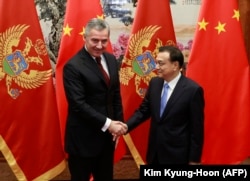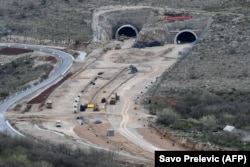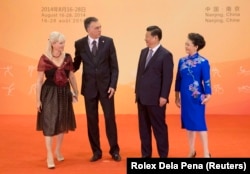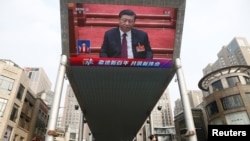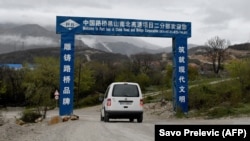
PODGORICA -- Montenegro says it needs help from the European Union to pay off a whopping $1 billion Chinese loan for a controversial road project that has left the Balkan country in a dire financial situation.
But EU spokeswoman Ana Pisonero told RFE/RL that the bloc "does not repay loans from third parties," though she added that Brussels did have concerns over "the socioeconomic and financial effects some of China's investments can have," as well as the risks of economic imbalances and "debt dependency."
She did say, however, that the EU was willing to offer support through its $10 billion Economic and Investment Plan for the Western Balkans. "The Economic and Investment plan will help leverage funding from other public and private investors, including from the European Investment Bank at very favorable conditions," Pisonero said.
The long-delayed and still-incomplete highway finds itself at the heart of a wider geopolitical contest on the EU's doorstep, where China's influence in the Balkans has expanded dramatically in recent years.
The rebuffed call to Brussels for assistance comes as Montenegro faces a looming repayment deadline for the highway -- which is being built by the China Road and Bridge Corporation (CRBC) -- and is grappling with a host of political and financial challenges, including a tourism-dependent economy that has contracted significantly due to the pandemic and weakened its repayment ability.
China holds approximately one-quarter of Montenegro's total debt, which reached 103 percent of GDP last year, and if Podgorica defaults on its loan the contract for the road project gives China the possibility to access land and assets in the Balkan country as collateral.
According to the current contract with the Export-Import Bank of China, the first loan payments are due in July.
The stakes are now high for both Brussels and Podgorica.
Montenegro must now search for other options for its financial future, while the EU must look for a way to shore up its standing in the Western Balkans, a region where China continues to improve its ties amid the pandemic by strategically donating vaccines and providing aid in a time of crisis.
"It's not a surprise to see where the project ended up, it was trouble in the making from the start," Vuk Vuksanovic, a researcher at the Belgrade Center for Security Policy, told RFE/RL.
Debt Politics
With debt help from the EU not on the table, the new Montenegrin government that was narrowly voted into power in December must find a new solution. The loan was taken out by a previous government led by current President Milo Djukanovic, who continues to be a long-term force in the country's politics.
Montenegro, which became an independent country again when it broke away from Serbia in 2006, joined NATO in 2017 and is working to get the green light to join the EU. Like many countries in the Balkans, it also has strong ties to Russia and has increasingly looked to China -- under the guise of Beijing's Belt and Road Initiative -- for infrastructure and investment.
The current government of Prime Minister Zdravko Krivokapic has tried to distance itself from the highway project, raising concerns over being able to meet its debt obligations and tying the loan to its predecessors, who signed the deal in 2014.
Deputy Prime Minister Dritan Abazovic first publicly raised concerns in March, when he told Montenegrin lawmakers that the EU should help refinance the loan to protect the country from becoming dependent on China.
Montenegrin Finance Minister Milojko Spajic also joined the public effort, telling the Financial Times on April 11 that the EU helping the country with the Chinese loan was an "easy win" and "low-hanging fruit" for the bloc.
A Winding Road
Accepting the loan from the Export-Import Bank of China and building the highway was controversial from the very start. The project was designed to link the port of Bar on Montenegro's Adriatic coast to landlocked neighbor Serbia. The highway itself is divided into three sections, with the Chinese loan only covering the first 41 kilometers.
That stretch, which passes through mountains north of the capital, has been the most demanding, with an estimated 60 percent of it made up of bridges and tunnels. The first section of the highway is not yet completed, having faced planning problems and delays due to the pandemic. The government recently said it intended for the first section to be complete this year.
When the current government was the opposition it criticized the government for agreeing to the loan, raising concerns over the cost, a lack of transparency in the tender process, potential corruption, and the long-term economic risk it brought to the small Balkan country of 620,000.
Subscribe To Our New China Newsletter
It's impossible to tell the biggest stories shaping Eurasia without considering China’s resurgent influence.
China In Eurasia is a newsletter by correspondent Reid Standish in which he builds on local reporting from RFE/RL’s journalists to give you unique insights into Beijing’s ambitions. It's sent on the first and third Wednesdays of each month.
To subscribe, click here.
Doubts about the highway first surfaced after two feasibility studies, conducted in 2006 and 2012, showed it was not economically viable. Montenegro had tried and failed to secure funding from European sources before it turned to China.
"Some projects haven't been built for a reason," Jonathan Hillman, the director of the Reconnecting Asia Project at the Center for Strategic and International Studies, told RFE/RL. "Just because financing becomes available it doesn't mean that it should be accepted."
MANS, an EU-financed anti-corruption watchdog, also pressed the government at the time to provide lawmakers with data to support its vision and how the project would generate revenue before a vote to approve the Chinese-funded highway in 2014. But the government refused to do so and many details around the contract for the loan remain hidden.
Even before the current problems posed by the debt repayment deadline, the Chinese loan caused economic pain to the country, forcing the government to raise taxes and partially freeze public-sector wages in order to get its finances in order.
Because the government did not hedge against currency swings and failed to include a turnpike in its original plans, the cost of the project continued to soar, pointing to a looming debt problem. The highway itself proved to be extremely expensive, with an average estimated cost of $23.8 million per kilometer.
In 2018, the Center for Global Development, a Washington-based think tank, listed Montenegro as one of eight countries at risk of a debt crisis after receiving a Chinese loan.
"The risks around this highway were clear at the beginning," Hillman said. "This shows what can happen when there isn't proper accountability and effective oversight for these big infrastructure projects."
China In The Balkans
In addition to the economic problems it poses to Montenegro, the current saga also puts the EU in a difficult position in regard to China in the region.
China continues to loom large in the Balkans, deepening its footprint through infrastructure and energy projects. Beijing has also begun to build up stronger political ties in the region, forging a comprehensive partnership with Serbia that has allowed it to expand out to neighboring countries.
Montenegro is potentially attractive to China for a number of reasons. It gives Beijing a European presence on the Adriatic coast and closer political ties and heightened influence within the country could prove useful if Podgorica joins the EU.
For Brussels, how it decides to navigate this situation will impact its credibility in the Balkans, which has been negatively affected during the pandemic over problematic episodes involving the supply of medical equipment and vaccines.
Still, the EU is the region's top investor and main market and is exploring other avenues to assist Podgorica.
On April 12, French European Affairs Minister Clement Beaune tweeted that Paris was working with the European Commission to find a solution to Montenegro's debt problem and "reduce the dependence on China in the Balkans."
"This is a rare opportunity for the EU to step up in its backyard and push back against China," Vuksanovic said.
"But it also wouldn't be the first strategic opportunity that the bloc has squandered in the Balkans," he added. "Doing so would be a bad signal to the region and a green light to Beijing."





